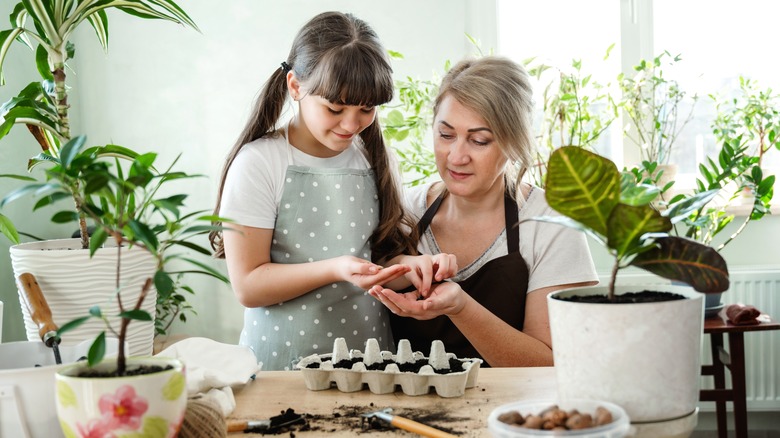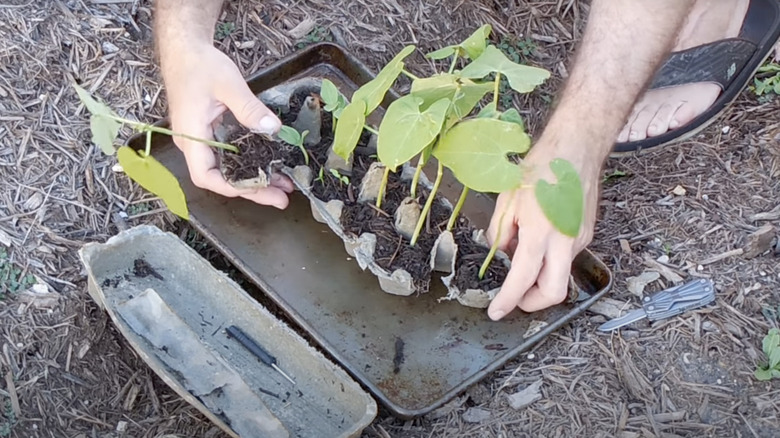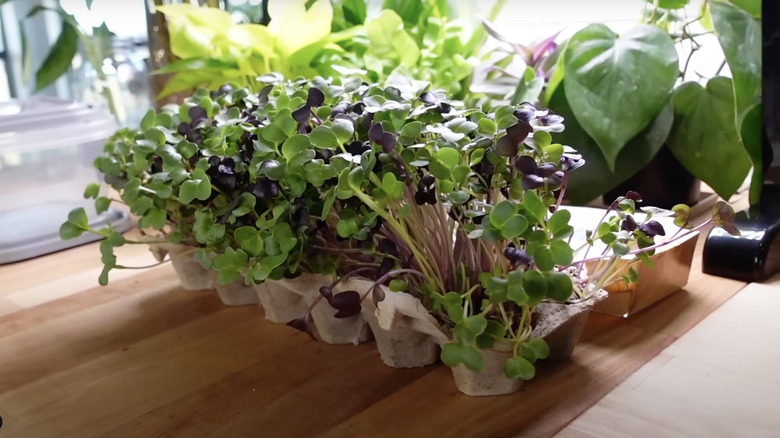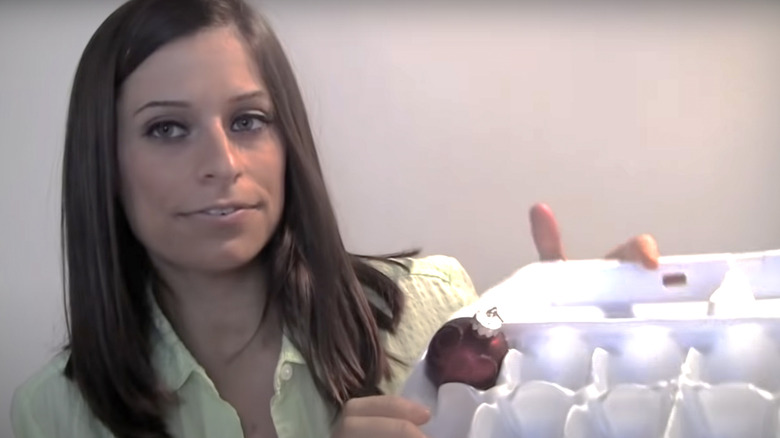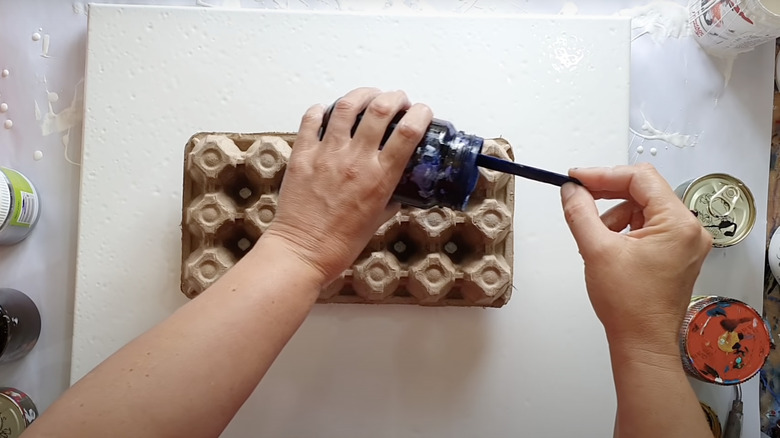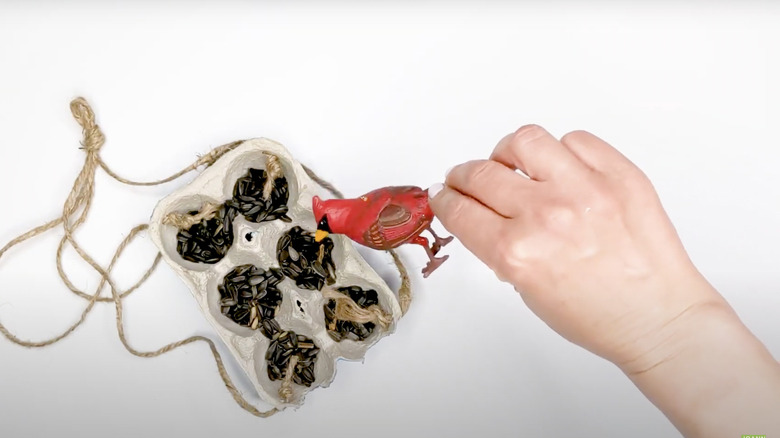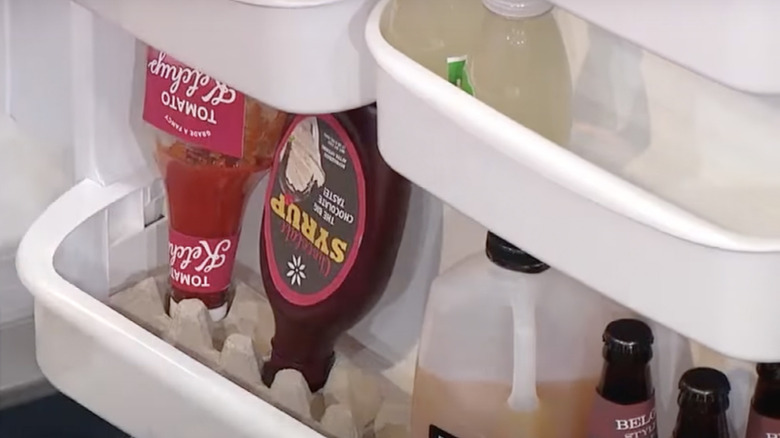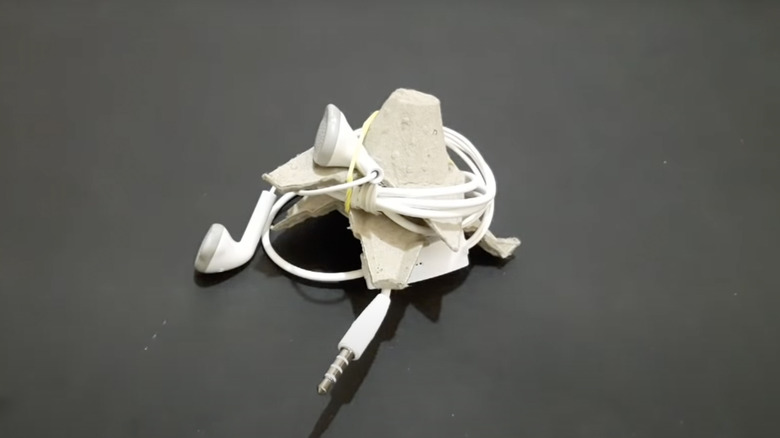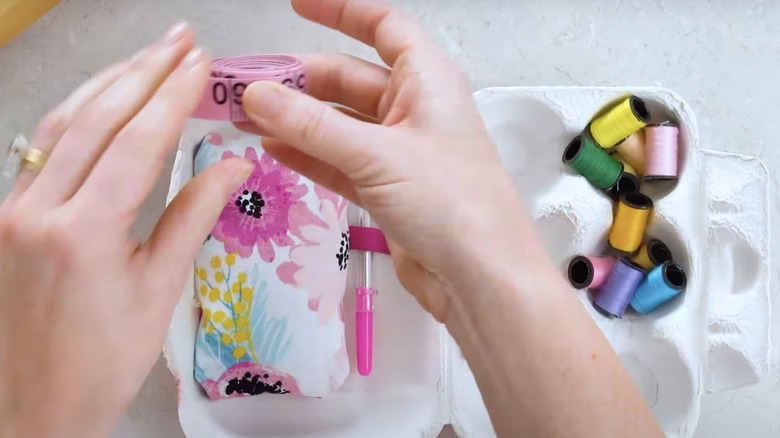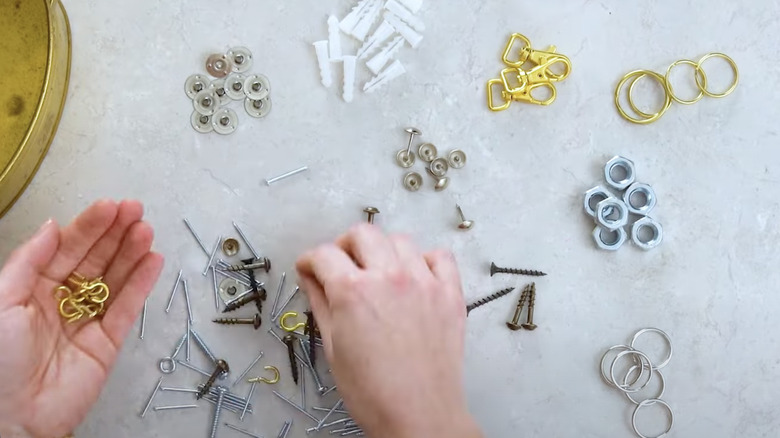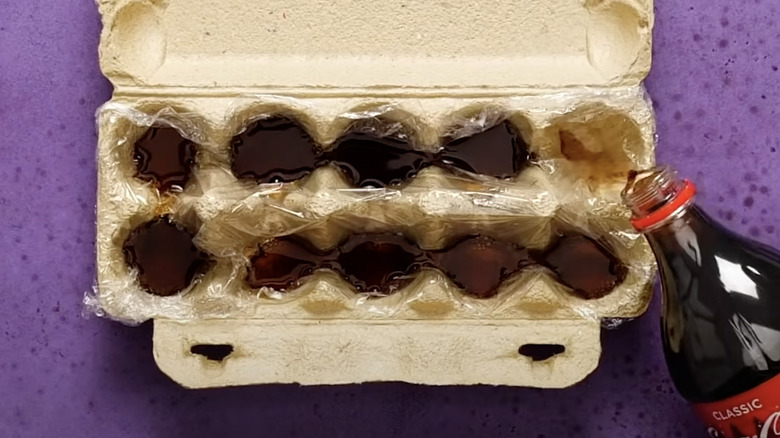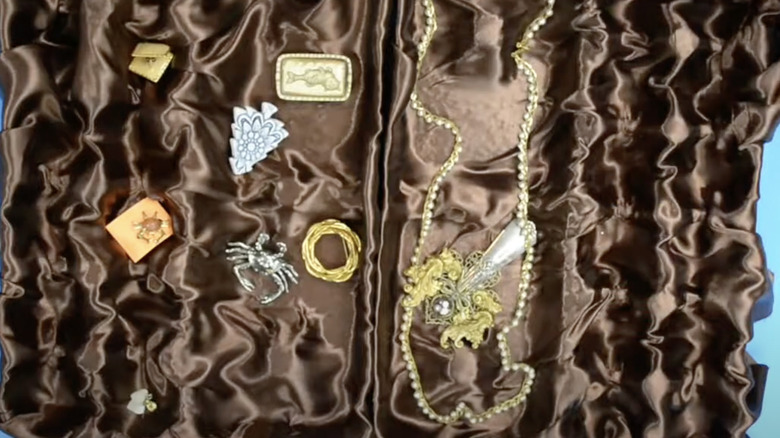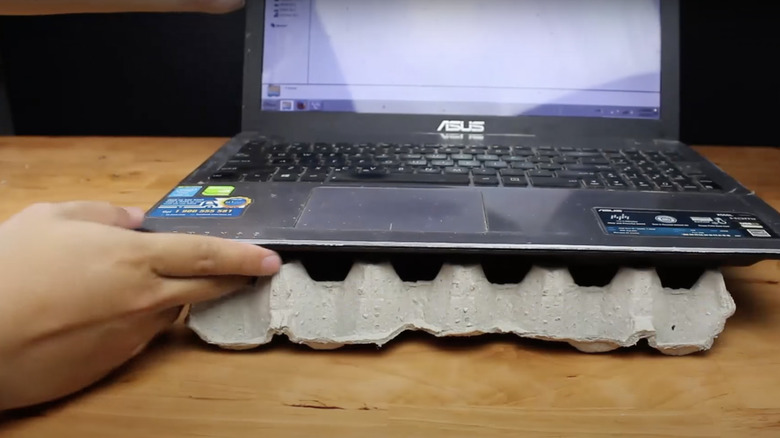12 Genius Ways To Use Old Egg Cartons Around Your House & In Your Garden
Eggs are one of the most common recipe ingredients, from nutritious breakfasts to scrumptious desserts. Most grocery stores and local farmers' markets sell their eggs in six or twelve-compartmented trays, which are often made of cardboard, plastic, or styrofoam. As long as they are thoroughly cleaned, all three materials are recyclable. Even so, you should know there are ways to repurpose these containers yourself so you can engage in more creative pursuits outside of traditional recycling.
Egg cartons make great tools and containers for various household and gardening activities. Adults and children alike can use them for organization, purposeful storage, arts and crafts, and other home activities, making them useful outside of solely storing eggs. Once you finish off your next batch of eggs, don't be so quick to toss your old carton with the rest of your recycling. Explore your artistic side and learn more about how these segmented trays can be used around your home in the article below.
Start seedlings or propagate cuttings
Whether you have a flourishing outdoor garden or a thriving indoor houseplant collection, starting your own plant from scratch can be a tricky business. An egg carton allows plants to be nurtured in individually controlled environments as they develop root systems. All it takes is an empty carton, plant seed or cutting, a potting soil mixture, scissors, and water.
Get started by purchasing a pack of seeds or removing a cutting from an already-owned plant. Use scissors to remove the egg holder lid, leaving the little pockets for eggs exposed and easily accessed. Fill them with potting soil, perlite, and fertilizer; this mixture may vary depending on the type of plant you're trying to start. Make sure you poke small holes in the bottom of these egg trays so water drains properly after you water them.
Continue to nurture seeds or cuttings in these trays until they are grown enough to be transferred into a more permanent home. Water the cups, and once the plant has sprouted, separate the compartments with scissors and plant them in individual pots. If you use a cardboard egg tray, it will decompose over time, leaving your seedling to grow independently. On the other hand, plastic or styrofoam will not decompose in your plant's lifetime, so you'll have to remove the sprout from the cup and plant it separately into the pot.
Grow microgreens in a controlled environment
Growing your own plants for consumption is highly rewarding. Nothing is more satisfying than cutting pieces from your own garden to add as ingredients or garnishes to homemade recipes. Microgreens are seedlings of edible plants and herbs. As their name implies, they are smaller-sized, and their leaves make great additions to omelets, meat dishes, salads, soups, and other meals. And you can grow microgreens in your discarded egg cartons.
All you will need is seeds from herbs or vegetables, an empty egg carton, potting soil, and water. Fill the pockets with soil, insert the seeds, and water them thoroughly. Set the egg carton on another tray so excess water has somewhere to drain. The plants should take around two to three weeks to grow, and you can harvest them once they're several inches tall. When you harvest, be careful not to take more than one-third of the plant at a time, which shocks your plant and deteriorates its health. Don't snip your microgreens unless they're growing quickly and appear healthy. Harvesting a wilting plant only weakens it and makes it harder for it to survive.
Safely store holiday ornaments
Winter decorations are only used for a month or two out of the year, and they spend most of their time stored away in attics, basements, and closets. When the holiday season wraps up and it's time to box up your ornaments, you must store them in a manner that keeps them safe for the foreseeable future. Egg cartons are a perfect home until the holidays come around again due to their padded individual pockets that are perfectly sized for holding baubles.
There isn't much to this trick. Simply unhook any ornaments or decorations that are roughly two inches by two inches in size and lay them safely in the individual slots of an egg carton. It's recommended you use a styrofoam or cardboard carton since they have softer compositions that provide sufficient padding when you close the lid. Just ensure you tape the carton shut to ensure it stays sealed with the ornaments safely nestled inside.
Use the compartments for different paint colors
A compartmented palette is essential for painting projects involving watercolor, acrylic, and other water-based colors. It's easy to purchase single-use palettes for cheap, but there's no need when you can repurpose a commodity you already have in your home. Egg cartons are the perfect shape and size for keeping paints separate and contained for artistic ventures.
Cut off the top of the carton, or you can open it all the way to make space for paintbrushes on the flatter side. Pour each color into the different cells on the compartmented side and add water to the coloring if needed. With just these few steps, your paint palette is ready for use. As an added plus, you can use the notches between egg slots to prop up your paintbrush during breaks, so you don't have to worry about dripping paint on the surrounding floor or table. Don't forget to lay down protective newspaper, cardboard, or tarp to protect any surfaces during your project.
Create a DIY bird feeder
Tossing old egg cartons in the recycle bin isn't the only eco-friendly way to deal with them. Try repurposing these containers to benefit nature right outside your door. Using styrofoam, plastic, or cardboard cartons, you can create a DIY bird feeder to nourish local avian populations.
All you need is the egg carton itself, string or twine, and homemade or store-bought bird feed. Cut off the lid and save the bottom half with the individual pockets. String a long piece of thread or twine through the holes in the carton so it can hang horizontally with the pocket-side facing upright with a set of six or twelve little bowls. Keep in mind that a six-egg carton will be more balanced since the strings won't have to hold up as much feed.
Pour your chosen birdseed into the bowls and hang it in a safe but accessible place. The best places to put bird feeders are about a foot from natural cover, near bushes and trees. The vegetation provides shelter from predators and blocks wind, keeping the feeder from flapping too wildly on windy days. However, the openness of the location also gives birds a clear view of potential threats that may approach while they eat.
Store refrigerated condiments upside down
Many sauces, dressings, syrups, and spreads are better off being stored upside down. It helps you get every last drop of delicious food out of the container since it's already pressed against the nozzle or lid. However, the real struggle is figuring out how to store your sauces upside down in an organized fashion so they don't topple over whenever you open and close the refrigerator door.
Depending on your fridge model, a cut-in-half egg carton may nestle perfectly in the side door of your fridge. If not, you can place the cardboard, plastic, or styrofoam piece on one of the shelves. Either way, the individual egg pockets are great for holding your sauces upside down. The additional perk is that even if the condiments leak or drip, they'll dribble into the carton material, keeping your refrigerator shelves clean and free of messes.
Organize electrical cords
Electronic devices, appliances, and fixtures are a dominant force in modern households. Although "cordless" chargers and kitchen appliances are becoming more popular, even their chargers still need to be wired into a house's electrical supply via a long cable. These electric lines often become a tangled mess, and it's difficult to determine which wire connects to which device or outlet.
The best way to keep these items orderly is to twirl the excess length around repurposed egg carton pieces. Take a cardboard egg tray and cut out the tall triangle portions — the parts originally used to divide the egg pockets. Wrap a cord in an infinity-shape over and under the base of each triangle, efficiently swaddling the triangle until all excess wiring is compact and tightly wound. Use a rubber band or tuck the wire into itself to keep it in place. This is a great method for winding up loose wires in drawers, behind TV stands, under desks, or anywhere else you have a collection of electronically powered devices.
Separate sewing threads by color
Fans of sewing, embroidery, cross stitching, and other crafts involving needles and threads often have collections of dozens or hundreds of different floss colors. In fact, DMC Mouliné is the leading manufacturer of embroidery floss, and they advertise almost 500 different colors. Though most sewing aficionados don't have that many threads, even owning a small fraction of that number can lead to a tangled mess of colors in your sewing box, drawer, or closet. But an egg carton can help.
Any size egg carton will do for this DIY organization technique. You can leave the container as is or paint and decorate the outside to make it more attractive. The inside, however, will be used to store spools of thread by shade. The egg pockets are large enough to hold multiple thread spools, enabling you to keep light, dark, metallic, and similar color groups together.
This is also an ingenious method to store strings for a current project. Usually, individual projects only require a few dozen colors, which you don't want getting mixed up with currently unused pieces from your vast collection. In addition to storing embroidery floss, you can also use extra pockets to store other sewing materials, like buttons, measuring tape, needles, and pins.
Organize hardware
The pockets of an egg carton are ideal for small item storage, and its flattened profile makes it easy to slide into shelves and drawers. If you're looking for a practical, organized method for storing miniature hardware fasteners, look no further than the pockets of an egg container. Start by laying out all your hardware pieces, including spare screws, bolts, anchors, staples, nails, nuts, and other bulk mechanical items. Organize them by type or size before dropping each category into an individual egg pocket.
The next time you're hanging up new decorations, fixing up furniture, or embarking on another mechanical project, it'll be easy to find the fastener you need. If you have a particularly large collection of these items, you can also organize them by material, metal color, and size. To keep the pieces from jostling and mixing up when transporting the egg carton from place to place, cut a piece of construction paper or other rectangular material to fit over the individual pockets. This will keep them enclosed when you close and tuck away your new storage case.
Combine it with plastic wrap to make an ice tray
Many modern refrigerator models are outfitted with automatic water and ice dispensers. However, not everyone has access to these luxuries. If you don't have one of these appliances, your ice dispenser operates insufficiently, or you like extra ice on hand, you're in luck. Making your own ice isn't rocket science; all it takes is a suitable container and some water.
You don't need to go out and buy an ice tray — instead, you can repurpose the carton from your last batch of eggs. Pull out a layer of plastic wrap or aluminum foil over the side of the carton with the individual pockets. Mold the wrap to fit in the pockets, pressing it snugly to the sides and ensuring you don't rip the covering or accidentally poke any holes. Carefully pour filtered faucet water, a water jug, or your drink of choice over the egg carton, filling each pocket three-quarters of the way with liquid. Be careful not to fill them to the brim, as this can lead to leaks and make it harder to break the cubes apart when you need to use them. Carefully transport the filled egg container to your freezer and slide it right-side-up into an open spot. The makeshift tray should be full of ready-to-use ice cubes within one to two hours.
Stash earrings, charms, and other small jewelry
Jewelry are common belongings in households, and no matter how cheap or expensive your pieces are, they are often very small in size. It can be difficult to keep track of your assortment of earrings, charms, chains, rings, and backings collected from gifts, inheritance, and self-indulgent purchases over the years. If you're looking for a handy way to store them, look no further than a recycled egg carton.
The egg pockets can store jewelry similar to how you may store hardware fasteners or thread spools. Organize your trinket collection by type, style, or color, dropping each category into its own cell in the egg container. The more jewelry you own, the more converted cartons you can use without ever having to drop a penny on a superfluous vanity box.
You can leave the cartons as they are or decorate them as you see fit. Some people simply paint the outside, while others line the inside with glossy fabric. As an artistic note, acrylic paint works on plastic, cardboard, and styrofoam, making it easy to beautify your egg tray exterior. Store the DIY jewelry box in a closet, dresser, or open shelf as you see fit.
Prop up your laptop for better cooling
The world is becoming more and more technologically focused, and many people own some form of computer, whether it's a complex desktop machine or a simple laptop. Newer software and games take a lot of memory and processing to run, forcing both types of systems to work harder. While you can add fans and easily upgrade components in desktop builds, laptops aren't as customizable.
Even expensive laptops can feel hot to the touch and overheat when running multiple or complex tasks. One way to keep your laptop from getting too hot is by propping it up to cool itself and circulate air below and around it. Try propping your device up on the elevated ridges of an egg carton. The spaces between egg cells allow air to flow, letting your laptop fans operate without obstruction. This can help your laptop maintain a safe temperature, provide a better performance rate, and preserve its battery life during use.
